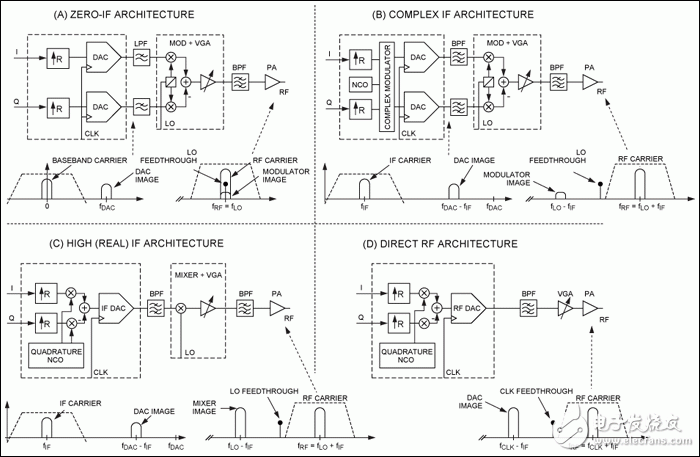introduction
After several years of development, the radio transmitter gradually transitioned from a simple intermediate frequency transmission architecture to an orthogonal intermediate frequency transmitter and a zero intermediate frequency transmitter. These architectures still have limitations, and the latest RF direct conversion transmitters can overcome the limitations of traditional transmitters. This paper compares the characteristics of different transmission architectures in wireless communication. RF direct conversion transmitters use high-performance digital-to-analog converters (DACs), which have obvious advantages over traditional technologies. The RF direct conversion transmitter also has its own challenges, but paves the way for a true software radio transmission architecture.
RF DACs, such as the 14-bit 2.3Gsps MAX5879, are key circuits in the RF direct conversion architecture. This DAC provides excellent spurious and noise performance in a 1 GHz bandwidth. The device's innovative design in the second and third Nyquist bands supports signal transmission and can synthesize RF signals at output frequencies up to 3 GHz. The results verify the performance of the DAC.
Traditional RF transmitter architecture
In the past few decades, the traditional transmitter architecture has been used to achieve superheterodyne design, using local oscillator (LO) and mixer to generate intermediate frequency (IF). Mixers typically produce two image frequencies (called sidebands) near the LO, which are useful for filtering out one of the sidebands. Modern wireless transmission systems, especially base station (BTS) transmitters, mostly perform I and Q quadrature modulation on baseband digitally modulated signals.

Figure 1. Wireless transmitter architecture.
Orthogonal intermediate frequency transmitter
The complex baseband digital signal carries two paths at the base: I and Q. The advantage of using two signal paths is that one of the IF sidebands is eliminated when the two complex IF signals are synthesized using an analog quadrature modulator (MOD). Due to the asymmetry of the I and Q paths, the image frequency of the modulator is not ideally cancelled. This orthogonal IF architecture is shown in Figure 1(B). In the figure, the I and Q baseband signals are interpolated (coefficient R) using a digital quadrature modulator and a LO numerically controlled oscillator (NCO), and modulated to positive Submit IF carrier. The dual DAC then converts the digital I, Q IF carrier into an analog signal that is sent to the modulator. In order to further increase the suppression of unwanted sidebands, the system also uses a bandpass filter (BPF).
Zero intermediate frequency transmitter
In the zero intermediate frequency (ZIF) transmitter shown in Figure 1(A), the baseband digital quadrature signal is interpolated to meet the filtering requirements; it is then fed into the DAC. The quadrature analog output of the DAC is also sent to the analog quadrature modulator at baseband. Because of the conversion of the entire modulated signal to the RF carrier of the LO frequency, the ZIF architecture truly highlights the "charm" of quadrature mixing. However, considering that the I and Q paths are not ideal paths, such as LO leakage and asymmetry, an inverted signal image (within the range of the transmitted signal) will be generated, causing signal errors. In a multi-carrier transmitter, the image frequency signal may be close to the carrier, causing in-band stray radiation. Wireless transmitters often employ complex digital pre-distortion to compensate for such artifacts.
RF direct conversion transmitter
In the RF direct conversion transmitter shown in Fig. 1(D), a quadrature demodulator is used in the digital domain, and LO is replaced by NCO, so that almost perfect symmetry is obtained in the I and Q paths, and there is substantially no LO leakage. So the output of the digital modulator is a digital RF carrier that is fed into the ultra-fast DAC. Since the DAC output is a discrete time signal, an aliased image frequency is generated that is equidistant from the DAC clock frequency (CLK). The DAC output is filtered by the BPF, the RF carrier is selected, and then sent to a variable gain amplifier (VGA).
High intermediate frequency transmitter
The RF direct conversion transmitter can also use this method to generate a higher intermediate frequency digital carrier, as shown in Figure 1(C). Here, the DAC converts the digital intermediate frequency to an analog intermediate frequency carrier. The DAC is then filtered out using the frequency selective characteristics of the bandpass filter. The desired intermediate frequency signal is then sent to the mixer to produce two sidebands of the IF signal mixed with the LO and filtered by another bandpass filter to obtain the desired RF sideband.
Clearly, the RF direct conversion architecture requires a minimum of active components. The RF direct conversion architecture avoids I and Q channel imbalance errors and LO leakage by replacing the analog quadrature modulator and LO with an FPGA or ASIC with a digital quadrature modulator and NCO. In addition, because the sampling rate of the DAC is very high, it is easier to synthesize a wideband signal while ensuring that the filtering requirements are met.
High-performance DACs are key components of RF direct-conversion architectures that replace traditional wireless transmitters that require RF carriers up to 2 GHz or higher, with dynamic performance to the baseband or IF performance offered by other architectures. The MAX5879 is one such high-performance DAC.
Qunsuo have more than 15 years experience in proving Barcode Scanner . We provide 1D Barcode Scanner and Qr Code Scanner , help customers from various industries. All of our barcode scanner support connecting with Android IOS via bluetooth. Furthermore, Our barcode scanner also support connecting with PC via 2.4G wireless module. Qunsuo provide portable scanner, Finger Barcode Scanner and Handheld Barcode Scanner. If any interests, please feel free to send inquiry to us for more information.

Mini Qr Code Scanner,Micro Usb Barcode Scanner,Mini Usb Barcode Scanner,Ipad Mini Barcode Scanner
Shenzhen Qunsuo Technology Co., Ltd , https://www.qsprinter.com